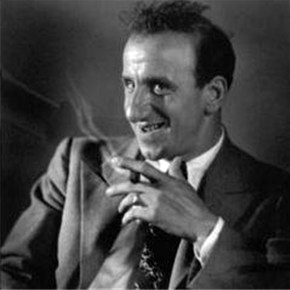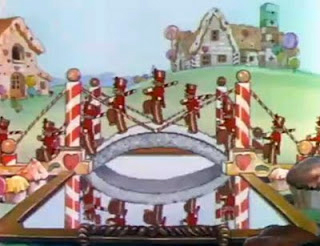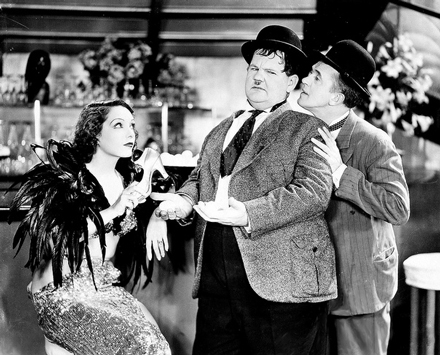
 |
|
|
|
Sometimes the only cure for what ails you is a good party picture, one with a scant chance of finding an important theme or socially relevant idea, a picture that's fun for its own sake. Over the years I'd return to the same titles, at least until their images got burned into my retinas -- Casino Royale, 1941, The Blues Brothers. Jokes and music and funny men -- I suppose It's a Mad Mad Mad Mad World qualifies as well. Back in the day studios filled this need with popular variety musical comedies, often loading them with whatever contract talent was around and needed to be kept busy. Paramount had the marvelous pre-Code International House and its Big Broadcast series, one of which introduced Bob Hope to the screen. When these things work, they can be great, especially with an audience. Back at U.C.L.A. International House, with W.C. Fields, Burns & Allen, Bela Lugosi and Cab Calloway singing about reefers had us screaming in delight. 
Some of MGM's earliest talkie musicals were revue-format variety shows, with a stage presentation format. Somebody had the bright idea of tossing the studio's contract comedians into a grab-bag show, in much the same way that they had created the all-star drama Grand Hotel. MGM had dropped Buster Keaton but they had Laurel & Hardy, Jimmy Durante and The Three Stooges, who at the time were billed as Ted Healey and his Stooges. 1934's Hollywood Party is a farce made by committee, or whoever was free to work on its behalf. So many directors worked on it that the film carries no director credit. Richard Boleslawski, Allan Dwan, Edmund Goulding, Russell Mack, Charles Reisner, Roy Rowland, George Stevens and Sam Wood are the big and small names listed in the IMDB ... one or two may have shot most of the show, with others pinch-hitting for single scenes, or for all we know, single days. Did George Stevens direct the Laurel & Hardy scenes? The story is lighthearted nonsense. Foolish movie comedian Jimmy Durante is a screen hero with the name "Schnarzan", a Tarzan character with a big nose. His Jane is comedienne Lupe Velez (of The Girl from Mexico), who always seems in imminent danger of a serious wardrobe malfunction. 1 Jimmy's problem is that nobody likes his Schnarzan movies because of those "old flea-bitten lions" he's been wrestling lately. And unfortunately, an upstart movie personality called "Liondora" (Georges Givot) has bought up a new collection of really good rough-tough lions. Jimmy's response is to throw a fantastic, never to be forgotten Hollywood Party, where all the right people can get together and behave like madmen. That's exactly what happens. The main "characters" can be something of a drag. Millionaire Charles Butterworth is slow with the bad jokes. Hekeeps burning big $ bills to prove how rich he is -- and would pull the movie down if his footage weren't curbed. Silent movie comedienne Polly Moran is slightly more entertaining, with little to play. And also burning up the screen time are the misused Eddie Quillan and June Clyde, as a young dancing-singing couple. Almost everything else, though, ranges from amusing (Durante) to borderline inspired (Laurel & Hardy). Durante's Schnarzan is promoted in a fake trailer that is only the first of an endless series of "schnozz" jokes that don't present the durable comedian at his best. But the MGM experts have Durante tangle with one heck of a ferocious-looking lion. It's Durante via split-screen in a few shots. In others it's a trainer or stuntman who allows himself to be mauled and dragged all over a set, all the while keeping his face away from the camera. It's great stuff. Testing one's knowledge of trivia is Jack Pearl, a radio comic famous for the line, "Vas you dere, Charlie?" Pearl brings his "Baron Munchausen" character to the party, which is already clogged with gangsters and rival agents for Liondora. And was that someone in an ape suit lumbering around the set? Right now, two days after seeing Hollywood Party, it's difficult to remember exactly how it goes. 
This leaves the rest of the movie open for freestanding episodic material. Various scantily clad women scatter at the sight of a mouse, who turns out to be none other than Mickey Mouse, voiced by Walt Disney himself. It's the original, Mark I Mickey, the little hellion who smacks Durante in the, what else, nose. The little rat's appearance is followed by a full Disney cartoon in 3-strip Technicolor, The Hot Choc'late Soldiers. This warped, vaguely anti-war musical fields has an army of proud candy men, that march off to war and then come back shot to bits. The sun comes out, and they all melt into slime. It's much more odd than funny, which is perhaps why Disney sold it to MGM!
The Three Stooges show up to take a bit of abuse from their Also making a big impression is Lupe Velez, the original "Mexican Spitfire". She bounds through the MGM back lot jungle in a costume made of little more than a few feathers, and is genuinely funny in her every appearance. As few in Hollywood knew how to write for Velez's frantic verbal talents, she's actually at her best here, where she can practically make up her scenes as she goes along. One setup has her throw a conniption fit over a telephone call. She kicks the phone around while letting loose a tirade of non-stop unintelligible Spanish, like Ricky Ricardo only much more 'earthy'. I caught what may be two or three Spanish obscenities, but anybody who cocks and ear will hear Velez end her screaming fit by screaming a very clear, "YOU PIECE OF CHIT!" This is 1934 and the dumbbell censors must have thought it was just more Spanish. It's phenomenal. Riding to the rescue are Laurel and Hardy, who make a fun entrance with an extended gag at the front door, and then engage in a slapstick battle with Lupe Velez at the bar, breaking eggs over each other. It's all performed in the slow burn, one-thing-after-another L&H style. It gets pretty dicey, or gooey. Velez finally drops an egg down Hardy's pants and give his tummy (or that general area) a slap. Hardy does a reaction-take to the camera that can only be chalked up as rowdy bathroom humor. When Velez delivers the coup de grace with her elbow and a slap, her costume becomes completely unhinged. The talented Velez was surely up for anything ... I'd imagine she'd be just as outrageous at a real Hollywood party. Hollywood Party has plenty of music, including a song by Shirley Ross. But the number that sticks is Rodgers and Hart's title tune sung by Frances Williams. It's very catchy. Somebody came up with an ersatz Busby Berkeley musical sequence that has a couple of circular patterns, plastic costumes and an art deco switchboard, along with a lot of confused-looking party action combined via some very clean MGM optical work. It's all very gaudy, and the close-up of Ms. Williams' big smile carries exactly the right message. Hollywood Party has the earmarks of a "big show" that apparently took forever to film; the original title was "Hollywood Revue of 1933". 
We're told that plenty of interesting folk can be spotted as extras, and perhaps as fugitives from cut scenes. But easily identified are Leonid Kinskey as a driver, and Robert Young as a radio announcer. As Young was already a notable member of the MGM stable, perhaps his main scenes were cut, or he was steered into the show as a cameo. Does the movie come to a real ending? It's difficult to say. The story is too loose to be described as having loose ends. Very little is resolved, and the part that is, is buttoned up with Durante's dream. The last we see of Stan and Ollie, they're yanking up the side wall of a wagon-cage, loosing some really ferocious lions into the middle of the party. At least that shows good judgment! 2 
The Warner Archive Collection DVD-R of Hollywood Party comes from excellent materials -- for some reason this show has always been in good shape. The Technicolor Disney sequence looks the best I've seen it. The WAC has lined up a bounty of extras. In addition to the original trailer, another menu choice leads us to an Audio Vault with at least ten pre-recordings of unused songs -- outtakes and deleted tunes. The talent is identified, where known. This is rare for a film of this vintage, and something Hollywood musical-ites will certainly want to hear.
Get up, get out , get in it! Hollywood Party! Nobody sleeps tonight!
On a scale of Excellent, Good, Fair, and Poor,
Hollywood Party rates:
Footnotes:
1. Hollywood Party was released in June of 1934, right on the cusp of the enforcement of the Production Code. So pay attention while there's something to see, men.
2. It would be funny to do a stealth edit in Cecil B. DeMille's outrageous pre-Code Christians-to-the-Lions epic The Sign of the Cross: Just as Nero orders his minions to release the lions on the cowering, devout Christian martyrs, we'd cut to the shot of Stan and Ollie merrily letting a lion loose. DeMille's perverse spectacle could use a touch of humor!
Reviews on the Savant main site have additional credits information and are often updated and annotated with reader input and graphics. Also, don't forget the 2011 Savant Wish List. T'was Ever Thus.
Review Staff | About DVD Talk | Newsletter Subscribe | Join DVD Talk Forum |
| ||||||||||||||||||